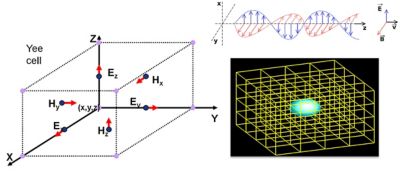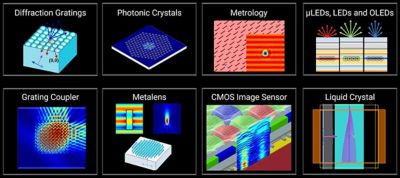-
United States -
United Kingdom -
India -
France -
Deutschland -
Italia -
日本 -
대한민국 -
中国 -
台灣
-
Ansys is committed to setting today's students up for success, by providing free simulation engineering software to students.
-
Ansys is committed to setting today's students up for success, by providing free simulation engineering software to students.
-
Ansys is committed to setting today's students up for success, by providing free simulation engineering software to students.
-
Contact Us -
Careers -
Students and Academic -
For United States and Canada
+1 844.462.6797
ANSYS BLOG
January 23, 2024
What is Finite-Difference Time-Domain (FDTD)?
The finite-difference time-domain (FDTD) method is a 3D full-wave electromagnetic solver commonly used for modeling nanophotonic devices, processes, and materials.
While in photonics FDTD has become the industry standard, the finite element method (FEM) and the method of moments (MoM) are the predominant gold standard computational electromagnetic solvers in high-frequency electronics, each excelling in its own right. This article specifically focuses on FDTD for photonics simulations.
First introduced in 1966 by Kane S. Yee, FDTD is an algorithmic approach to solving James Clerk Maxwell’s transformative equations, officially known as Maxwell’s equations. Conceived in the 19th century, these equations not only unified electricity and magnetism, but also laid the groundwork for technologies such as radio, television, and wireless communication. Yee’s numerical method was not widely referred to as FDTD until the 1980s.
Maxwell’s FDTD Equations
Maxwell’s equations and the laws associated with them include:
- Gauss’ law for electricity: describes how electric charges produce electric fields
- Gauss’ law for magnetism: describes how magnetic fields do not have isolated magnetic poles
- Faraday’s law of induction: explains how a changing magnetic field induces and electromagnetic force (EMF) in a circuit
- Ampere’s law with Maxwell’s addition: relates electric currents to magnetic fields, incorporating the role of changing electric fields.

In FDTD, each field component is solved at a slightly different location within the grid cell (Yee cell), as shown above.
How Does FDTD Work?
In FDTD, the simulation domain is the space truncated by the simulation region and discretized by the mesh. When an FDTD simulation runs, the electromagnetic (EM) fields are calculated from Maxwell’s equations in every mesh cell and the solutions are repeatedly time-stepped. Spatial discretization allows for the representation of complex geometries and structures, while temporal discretization captures the evolution of EM fields over time.
What are the Applications for FDTD?
The FDTD method is generally suitable for design cases in which some or all dimensions of the object are comparable to the size of the wavelength of light. Its accuracy and versatility make FDTD the go-to solver for a wide range of photonic designs, including:
- CMOS image sensors
- LEDs, OLEDs, microLEDs, and liquid crystals
- Scattering and diffractive optics
- Metamaterials, metasurfaces, metalenses, and plasmonics
- Integrated photonics
- Photonic crystals
Although FDTD presents the most general solution to Maxwell’s equations, more efficient approaches are applied to specific applications such as for maximizing design flexibility for multi-layered and diffractive optical components. Similarly, a solver combination strategy for photonic integrated components can be employed to address different structures more efficiently, such as the eigenmode expansion (EME) method for light guiding structures. Building a strategic methodology for choosing the right solver for the right problem can impact both the design process speed and efficiency, as well as the accuracy of results.

The FDTD method is used in a wide range of nanophotonics designs.
What are the Benefits of FDTD?
Using FDTD, designers can thoroughly study polarization and wavelength-dependent interactions of light with different materials and structures. They can receive insight into optical phenomena such as reflectance, transmission, diffraction, interference, and absorption.
- Time and frequency domain analysis: FDTD provides a dynamic view of EM fields’ evolution over time. A built-in automated Fourier transform of the time-domain solution easily makes frequency analysis possible.
- Broadband capabilities: Because it is a time-domain method, FDTD can be used to calculate broadband results much faster from a single simulation.
- Complex geometries: FDTD thrives in modeling complex geometries and can handle any arbitrarily shaped structures.
- Accuracy and versatility: The method is inherently free of any physical approximations, making it highly versatile and accurate.
What are Challenges of FDTD?
The high accuracy and versatility of the FDTD method introduce some challenges, including:
- Simulation size: The maximum physical size of a device that can be accurately modeled is ultimately constrained by the available compute resources.
- Simulation time: The speed of FDTD simulations depends on several factors from the simulation setup and volume to the hardware specs of the computing system. In 3D, the simulation time is expected to scale with the following relation ~V . (l/dx)4, where V is the simulation volume and dx is the grid size. Thus, mesh accuracy and the design size can significantly impact the simulation time.
- Memory and computing power: The sheer number of spatial and temporal unknowns in an FDTD simulation grows exponentially with finer meshes and larger simulation volumes. This results in extremely large amounts of memory and computing power requirements.
- Memory bandwidth: Memory access and heavy data exchange between processors, particularly when dealing with sizable simulations, pose a main challenge in accelerating FDTD simulations.
How Do You Accelerate FDTD Simulations?
Ansys Lumerical leverages multiple advanced approaches to accelerate FDTD simulations.
Finely Tuned Algorithm
The FDTD algorithm in Lumerical has been fine-tuned at a fundamental level over decades to minimize computational overhead while delivering the highest accuracy. There are several patented and advanced features and functionalities to help streamline the simulation setup, including the mesh, monitors, sources, structures, materials, analysis groups, and more. Built-in advanced optimization frameworks can additionally accelerate the generation of optimized nanophotonic devices.
Parallel Computing
Ansys Lumerical FDTD has a highly optimized computational engine able to exploit multicore CPU computing systems and harness the parallel architecture of graphics processing units (GPUs) in high-performance computing (HPC) clusters. Both CPU and GPU architectures excel in parallel processing, addressing the need for simultaneous computation in FDTD simulations. HPC systems leverage this parallelism to distribute the workload, significantly enhancing simulation performance. Large simulation jobs can be partitioned into several independent computational threads to be executed in parallel enabling large simulations of 50-100 billion grid cells in less than a few hours.
As the complexity of simulations grows, so does the need for efficient and scalable computational resources. This is where the dynamic duo of Cloud Computing and HPC steps in, revolutionizing FDTD simulations. The Lumerical solution offers CPU and GPU-compatible simulation software that users can deploy on-premises or on the cloud.
For more information on FDTD simulation software on HPC and cloud, watch our webinar “Accelerating Photonic Design with HPC and Cloud.”
To learn more about the underlying solver physics and how to set up, run, and analyze an FDTD simulation, see the FDTD learning track on Ansys Innovation Courses.











